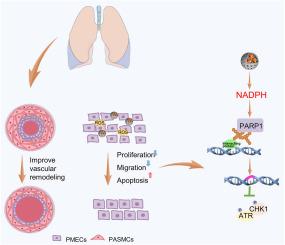Hydrogen-generated metal-organic framework nanoparticles for ameliorated pulmonary hypertension by ROS scavenging, hydrogen anti-inflammation, and reducing DNA damage
IF 8.2
2区 材料科学
Q1 MATERIALS SCIENCE, MULTIDISCIPLINARY
引用次数: 0
Abstract
Pulmonary hypertension (PH) is a malignant and progressive disease lacking effective treatments, characterized primarily by pulmonary vascular remodeling resulting from endothelial cells (ECs) dysfunction. The increase of reactive oxygen species (ROS) in a pathological state is the pivotal factor that triggers ECs dysfunction, primarily through the induction of DNA damage. Currently, there is a significant scarcity of drugs capable of reducing ECs DNA damage by eliminating ROS in the microenvironment. Therefore, we synthesis hydrogen-generated metal-organic framework nanoparticles (PdH/ZIF-8), which can not only release hydrogen continuously for over 24 h, but also has efficiently ROS scavenging activity. In vitro, PdH/ZIF-8 inhibits hypoxia-induced dysfunction of pulmonary microvascular ECs. In vivo models PdH/ZIF-8 accumulates in lungs rapidly and steadily, effectively alleviating pulmonary vascular remodeling, and ultimately significantly improving cardiac function. Further, PdH/ZIF-8 decreases expression of inflammatory factors. At the same time, PdH/ZIF-8 regulates the expression of poly ADP-ribose polymerase (PARP1), reduced ataxia telangiectasia mutated and Rad3 related (ATR)/cell cycle checkpoint kinase 1 (CHK1) phosphorylation. In conclusion, this work provides a novel and effective nanotechnology with the synergistic therapy of innocuous gas to the treatment of PH.

氢生成的金属有机框架纳米颗粒通过清除活性氧、抗氢炎症和减少DNA损伤来改善肺动脉高压
肺动脉高压(PH)是一种缺乏有效治疗的恶性进行性疾病,其主要特征是由内皮细胞(ECs)功能障碍引起的肺血管重构。病理状态下活性氧(ROS)的增加是引发ECs功能障碍的关键因素,主要通过诱导DNA损伤。目前,能够通过消除微环境中的ROS来减少ECs DNA损伤的药物非常缺乏。因此,我们合成了氢生成的金属有机框架纳米粒子(PdH/ZIF-8),它不仅可以连续释放氢超过24 h,而且具有高效的活性氧清除活性。在体外,PdH/ZIF-8抑制缺氧诱导的肺微血管内皮细胞功能障碍。体内模型PdH/ZIF-8在肺内快速稳定积累,有效缓解肺血管重构,最终显著改善心功能。此外,PdH/ZIF-8降低炎症因子的表达。同时,PdH/ZIF-8调节聚adp核糖聚合酶(PARP1)的表达,减少共济失调毛细血管扩张突变和Rad3相关(ATR)/细胞周期检查点激酶1 (CHK1)磷酸化。总之,这项工作提供了一种新的和有效的纳米技术与无害气体的协同治疗PH。
本文章由计算机程序翻译,如有差异,请以英文原文为准。
求助全文
约1分钟内获得全文
求助全文
来源期刊

Materials Today Nano
Multiple-
CiteScore
11.30
自引率
3.90%
发文量
130
审稿时长
31 days
期刊介绍:
Materials Today Nano is a multidisciplinary journal dedicated to nanoscience and nanotechnology. The journal aims to showcase the latest advances in nanoscience and provide a platform for discussing new concepts and applications. With rigorous peer review, rapid decisions, and high visibility, Materials Today Nano offers authors the opportunity to publish comprehensive articles, short communications, and reviews on a wide range of topics in nanoscience. The editors welcome comprehensive articles, short communications and reviews on topics including but not limited to:
Nanoscale synthesis and assembly
Nanoscale characterization
Nanoscale fabrication
Nanoelectronics and molecular electronics
Nanomedicine
Nanomechanics
Nanosensors
Nanophotonics
Nanocomposites
 求助内容:
求助内容: 应助结果提醒方式:
应助结果提醒方式:


